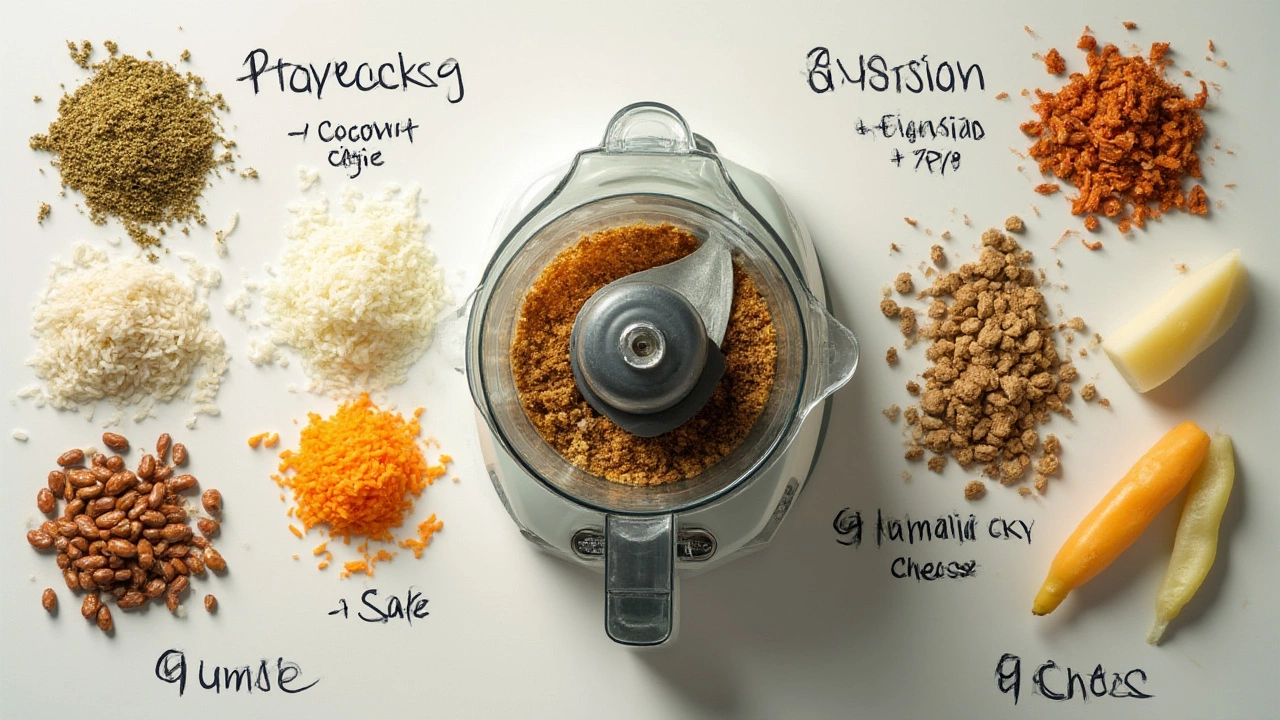Ever watched someone put chicken bones in their food processor like it's a high-powered woodchipper and felt your insides tighten up? Yeah, that's a kitchen nightmare in action. Just because a food processor can tackle a lot, doesn't mean it should handle everything. Some things can break the machine, cause safety headaches, or turn your meal into mushy regret. Don’t wait for a burning motor or the sickening crunch of broken blades to realize you made a mistake. Here’s the lowdown on what to steer clear of when you fire up your trusty food processor.
The Foods That Food Processors Hate
The number one thing I see people toss in their food processor thinking, "Eh, it’s fine," is hot food. Food processors are not fans of anything fresh from the stove. Pour in hot soup or stew, and before you know it, you’re cleaning up an exploded mess—pressure from the steam can force the lid off and splatter everything. Always let food cool first. This tip alone has probably saved me (and my wife, Priya, from more kitchen disasters than I can count!).
Next on the hit list: bones, pits, and shells. Want to shorten your food processor’s life? Try blending chicken bones, peach pits, or lobster shells (please don’t). The sharp blades aren’t made for crushing things this tough. If you’re after nut butters, go for shelled, unsalted nuts. Hard stuff like peach stones can break the blades, damage the bowl, and you’re left with a sad, useless appliance.
Stringy or fibrous foods are another classic mistake. Picture celery stalks or ginger root. These fibers can wrap themselves around the blades and motor shaft. Suddenly, your food processor smells like burning plastic and won’t start again. Banana peels, artichoke leaves, and rhubarb are in the same club. For these, stick to a good old-fashioned knife.
Don’t even try to process sticky, gummy substances like dough that isn’t designed for processors, super-thick caramel, or dried fruit packed together. Sticky stuff clogs the blades and puts huge stress on the motor. If you have to blend dried fruit, soak it first. Saves your processor and your patience.
Spices and coffee beans seem harmless—but most home food processors can’t handle tiny, hard seeds or grains. If you want them ground to dust, use a spice grinder or a blender built for dry ingredients. Food processors just move these bits around; they don’t pulverize them. You’ll end up with uneven powder and stressed-out blades.
Here’s a quick comparison to make things clearer:
| Item | Safe? | Why Not? | Better Tool |
|---|---|---|---|
| Hot Soup | No | Steam pressure can force lid off | Let it cool, then blend in batches |
| Chicken Bones | No | Too hard, can break blades | Professional meat grinder |
| Celery Stalks | No | Fibers jam/overheat blades | Chop by hand |
| Coffee Beans | No | Too hard, stays uneven | Coffee grinder |
| Sticky Dough | No | Gums up motor and blades | Stand mixer with dough hook |
So why is this such a big deal? Well, most food processors use motors between 400 and 1000 watts. That’s plenty for veggies, cheese, or even meat (without bones). But when you throw in something tough or sticky, the motor strains—sometimes stalls—and heats up. Some have automatic shut-off for safety, but not all. A burnt-out motor isn’t covered by most warranties if you abuse your gear.

Surprising Foods That Can Break Your Food Processor
You might think you know what’s safe, but a couple of foods catch even experienced cooks off guard. Take whole potatoes, for example. They seem soft enough, but raw potatoes have a dense, waxy texture that can make your blades bounce instead of slice. The result? Mush on the outside and big chunks riding around inside the bowl. The processor’s design just doesn’t let blades get enough grip. For perfect diced or shredded potato, stick to a food processor’s grating disk, not the main blade—or go old school and use a box grater.
Don’t try to chop large, hard cheese blocks either. A food processor can shred cheese, but only if you prep it right. Room-temperature cheese turns into goo and gums up the blades. Freezing cheese for a few minutes first makes shredding easy and keeps things from getting sticky. I once made the mistake of popping a big hunk of mozzarella straight in; I spent 20 minutes cleaning out the bowl and the blades, cursing the mess.
Large quantities of liquid are a no-go. Yes, you can make sauces, dips, and soups once the food has cooled—but the bowl isn’t perfectly sealed for high volumes. Pour too much in, and liquid seeps out the bottom, especially where the bowl connects to the motor base. For lots of liquid, use a blender, which is designed for this job. This is probably the most common reason food processors end up with sticky gunk in the motor housing.
Oily seeds like sesame and flax are another curveball. They turn into a gluey paste that coats everything inside the bowl. If you want to make tahini or flax paste, use a high-speed blender with a tamper instead. Even commercial processors have trouble with straight sesame unless it’s mixed with oil or water.
If you love baking, don’t use your processor for whipped cream or egg whites. The blades just can’t trap enough air to make those mixtures light and fluffy. That job is for a stand mixer or a whisk, if you like a workout before dessert. The texture from a food processor always ends up dense and disappointing.
Then there are very hard candies and sweets. Some people want to crush mints or candy bars for desserts. The truth is, unless you’re using tiny, soft pieces, candies put your processor through torture. The blades can chip or dull, and the plastic bowl might get spiderweb cracks. Better to stick them in a zip bag and hammer with a rolling pin. Your processor will thank you.
Here’s another pro tip: frozen fruits. Yes, smoothies are great, and the frozen stuff is less messy. But unless your processor advertises itself for ice or frozen food, you can burn out the motor in minutes. Always thaw fruits just a little, or use a heavy-duty blender instead.
| Erroneous Ingredient | What Happens | Suggested Fix |
|---|---|---|
| Whole raw potato | Bouncing, uneven chop | Use shredding disk or dice first |
| Hard cheese (room temp) | Turns into sticky ball | Freeze before shredding |
| Large liquid amounts | Leaks out, damaging motor | Limit to half-full, use blender |
| Oily seeds | Gluey paste | Process in small batches, add oil |
| Frozen fruit | Motor stalls/overheats | Thaw slightly or use blender |
This advice isn’t just for expensive food processors; even budget models deserve a little respect. No one wants to deal with smoky plastic or the smell of burnt electronics at dinnertime. Plus, a food processor that’s babied will make your life easier for years. If you’re not sure whether your food is processor-safe, check your user manual—they usually have a forbidden foods list tucked in the back pages.

Kitchen Hacks, Tips, and Safety for Food Processor Fans
Let’s talk about how to make your food processor last, even if you’re using it every single day. The golden rule? Prep your food so it’s ready for the processor, not the other way around. Small pieces go in easier, get chopped more evenly, and protect the blade’s sharp edge. Cut produce into chunks no bigger than a golf ball, and never shove more than the bowl’s marked capacity.
- Food processor blades are tough but not invincible. Don’t run the machine empty—always have something to process so the blades have a cushion.
- Alternate tough and soft foods in a batch. If you’re shredding cabbage and carrots, start with the carrot (harder) then add cabbage, so it has a chance to chop before softening from friction.
- If you’re anxious about fibers, pre-peel tough veggies like ginger, and slice stringy foods thinly. This reduces the load on the motor, and you get a smoother final result.
Let’s talk cleaning. Cleaning right away is key. Dried-on food sticks to everything, turning a two-minute clean-up into a 20-minute chore. Rinse the bowl, blades, and lids as soon as you’re done. No dishwasher? Mix a little warm water with a few drops of dish soap in the bowl, run the processor for a few seconds, and rinse. Job done.
Always store blades in a safe container or blade storage box. These things are crazy sharp—ask anyone who’s grabbed a loose S-blade from a sink full of soapy water. One nasty cut can put you off home cooking for weeks.
Heat is a silent killer. Motors hate it. If your food processor is struggling and starting to smell hot, pause and give it a break. Modern machines usually have some thermal protection, but older ones just quit working if you abuse them too much.
Check the seals on the lid and bowl regularly, especially if you process anything oily or citrusy—these can degrade plastic over time. My aunt destroyed her machine making endless jars of lemon pickle. Citrus is acidic and can pit the plastic if left unwashed.
If your appliance came with more than one blade or disk, read up on what each one does. People often use the wrong blade for the job, which doesn’t just affect results—it can put stress on the motor. S-blades do general chopping/pureeing, disks do slicing or grating, dough blades for proper mixing.
One hack for smaller batches: Place a piece of parchment under the food processor blade before assembling the bowl. This prevents tiny items like garlic, black pepper, or herbs from sticking to the bottom, so nothing gets wasted or left behind.
I’ve picked up something fun after years of cooking at home—if a food seems risky, I check online for kitchen disaster videos. It’s a wild world out there. Seeing what happens when someone puts a whole coconut or a block of frozen beef in their food processor is better than any warning label.
And remember, any weird noises—squealing, juddering, harsh vibration—should be a sign to stop instantly. Unplug, investigate, and never try to fix a stuck blade while the machine is plugged in.
More and more, I see food processor brands offering clear lists: what’s safe, what’s not, and how long you can run each speed. It’s a good move. If your processor is old-school and doesn’t include these, print out your own warning table and stick it inside a cabinet door near your prep space. Saves the day every time.
So, while food processors are a kitchen miracle, they aren’t superheroes. If in doubt about what you’re processing, take a second, prep it right, and remember: patience now means delicious food (and an unbroken machine) later.
